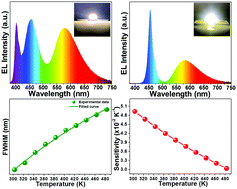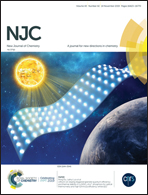Lithium ion doping triggered splendid quantum efficiency and thermal stability in Li2SrSiO4:xEu2+ phosphors for optical thermometry and high luminous efficiency white-LED†
Abstract
Eu2+/Li+-Codoped Li2SrSiO4 orange-yellow phosphors were developed for the applications of white light-emitting diodes (white-LEDs) and optical thermometry. Under near-ultraviolet and blue light excitation, the resultant phosphors exhibited the emissions of Eu2+ ions with an optimal doping concentration of 5 mol% and the concentration quenching mechanism was prevailed to be the dipole–quadrupole interaction. Through the incorporation of Li+ ions into the host lattices, the thermal stability and internal quantum efficiency of the synthesized phosphors were boosted. When the excitation wavelengths were 419 and 449 nm, the internal quantum efficiencies of the Eu2+/Li+-codoped Li2SrSiO4 phosphors were increased to 73% and 69%, respectively. The temperature dependent emission spectra were employed to characterize the thermal stability of the studied samples. The white-LED lamps utilizing the Eu2+/Li+-codoped Li2SrSiO4 phosphors as the orange-yellow component exhibited enhanced photoelectric properties. Furthermore, based on the temperature dependent bandwidth of Eu2+ ions, the thermometric performance of the resultant compounds was studied in detail and the maximum sensitivity was 0.049 K−1. The phosphors with multi-excitation wavelengths were suitable for high luminous efficiency white-LEDs and optical thermometers.



 Please wait while we load your content...
Please wait while we load your content...